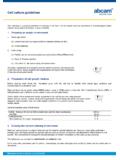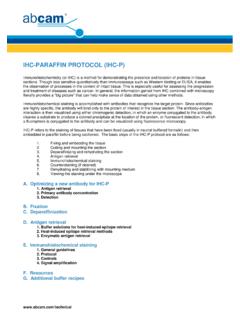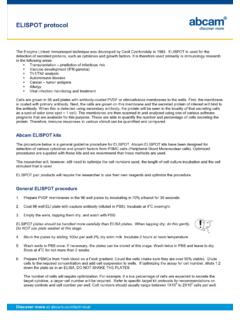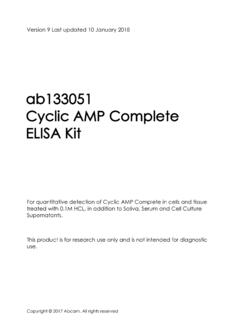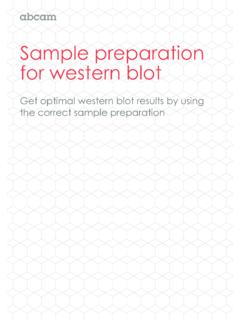Transcription of Abcam: Immunoprecipitation Protocol (IP)
1 Immunoprecipitation (IP) Protocol Immunoprecipitation is a method that enables the purification of a protein. An antibody for the protein of interest is incubated with a cell extract so that the antibody will bind the protein in solution. The antibody/antigen complex will then be pulled out of the sample using protein A/G-coupled agarose beads. This physically isolates the protein of interest from the rest of the sample. The sample can then be separated by SDS-PAGE for Western blot analysis. 1. Lysis buffers and other reagents 2.
2 Preparation of lysates 3. Pre-clearing the lysates 4. Immunoprecipitation 5. Choosing the correct beads- summary table Lysis buffers The ideal lysis buffer will leave proteins in their native conformation, minimizing denaturation of antibody binding sites while at the same time releasing adequate amounts of protein from the sample for subsequent analysis. Non-ionic detergents such as NP-40 and Triton X-100 are less harsh than ionic detergents such as SDS and sodium deoxycholate. Other variables that can affect the success of IP include salt concentration, divalent cation concentration, and pH.
3 To optimize, these should be tested within the following ranges (From Harlow and Lane, page 231; see References): Salts: 0 -1 M Detergent, non-ionic: 2% Detergent, ionic: Divalent cations: 0 10 mM EDTA: 0 5 mM pH: 6 - 9 1. Non-denaturing lysis buffer Use for antigens that are detergent soluble and can be recognised in native form by the antibody. Triton X-100 can be substituted for NP-40. 20 mM Tris HCl pH 8 137 mM NaCl 10% glycerol 1% Nonidet P-40 (NP-40) 2 mM EDTA Store up to 6 months at 4oC Immediately before use add: Protease inhibitors 2.
4 RIPA (RadioImmunoPrecipitation Assay) buffer More denaturing than NP-40 or Triton X-100 lysis buffer, RIPA buffer contains the ionic detergents SDS and sodium deoxycholate as active constituents and is particularly useful for nuclear membrane disruption for nuclear extracts. RIPA buffer gives low background but can denature kinases. 50mM Tris HCl pH 8 150 mM NaCl 1% NP-40 sodium deoxycholate SDS The 10% sodium deoxycholate stock solution (5 g into 50 ml) must be protected from light. 3. Detergent-free soluble protein lysis buffer Some soluble proteins may not require use of detergents.
5 Use this buffer with mechanical breakage of cells, repeated passage through a syringe or homogenization with a Dounce homogenizer. PBS containing: 5 mM EDTA % Sodium Azide Store up to 6 months at 4oC Immediately before use add: Protease inhibitors 4. Denaturing lysis buffer/buffer for non-detergent soluble antigens: Epitopes of native proteins are not accessible to antibodies that only recognise denatured proteins. When harvesting and lysing the cells, heat the cells in denaturing lysis buffer. This method can also be used for antigens that cannot be extracted from the cell with non-ionic detergents.
6 Use of DNase1 will aid extraction of proteins from chromatin. 1% SDS 5 mM EDTA Store up to 1 week at room temperature Immediately before use add: 10mM dithiothreitol or beta-mercaptoethanol Protease inhibitors 15 U/ml DNase1 Other reagents Protease inhibitors As soon as lysis occurs, proteolysis, dephosphorylation and denaturation begin. These events can be slowed down tremendously if samples are kept on ice or at 4 C at all times and appropriate inhibitors are added fresh to the lysis buffer. Mixtures ( cocktails ) of protease and phosphatase inhibitors are commercially available.
7 If not using a cocktail, two of the most commonly used protease inhibitors for IP are PMSF (50 ug/ml) and aprotinin (1 ug/ml). For more details of protease and phosphatase inhibitors, please see our Western Blot Beginner s Guide. Other reagents required: Sterile PBS pH Sterile PBS-BSA 1% (filtered) TBST buffer Loading/sample buffer for Western blotting 100 mM EDTA stock solution is made with g into 40 ml H2O. Add NaOH to dissolve and adjust pH to Finally, adjust the total volume to 50 ml. 2. Preparation of lysates Lysates from cell culture Non-denaturing: 1.
8 Place the cell culture dish on ice and wash the cells with ice-cold PBS. 2. Drain the PBS, then add ice-cold lysis buffer (1ml per 107 cells/100mm dish/150cm2 flask; per 5x106 cells/60mm dish/75cm2 flask). 3. Scrape adherent cells off the dish using a cold plastic cell scraper then gently transfer the cell suspension into a pre-cooled microfuge tube. 4. Maintain constant agitation for 30 minutes at 4 C. 5. Centrifuge in a microcentrifuge at 4 C. You may have to vary the centrifugation force and time depending on the cell type.
9 A guideline is 20 minutes at 12,000 rpm but this must be determined by the end-user ( leukocytes need a very light centrifugation). 6. Gently remove the tubes from the centrifuge and place on ice, aspirate the supernatant and place in a fresh tube kept on ice, and discard the pellet. Denaturing: 1. Add 100 ml denaturing lysis buffer per to 2 x 107 cells. 2. Mix well by vortexing vigorously 2 to 3 seconds at maximum speed. Transfer the cell suspension to a microcentrifuge tube. The solution can be viscous at this stage due to release of DNA.
10 3. Heat samples to 95 C for 5 minutes to denature 4. Dilute the suspension with ml non-denaturing lysis buffer. Mix gently. (The excess 1% Triton X-100 in the nondenaturing lysis buffer quenches the SDS in the original denaturing buffer). 5. Fragment the DNA by passing the lysed suspension 5 to 10 times through a needle attached to a 1-ml syringe. Repeat mechanical disruption until the viscosity is reduced to manageable levels. If the DNA is not fully digested, it can interfere with the separation of the pellet and supernatant after centrifugation.
